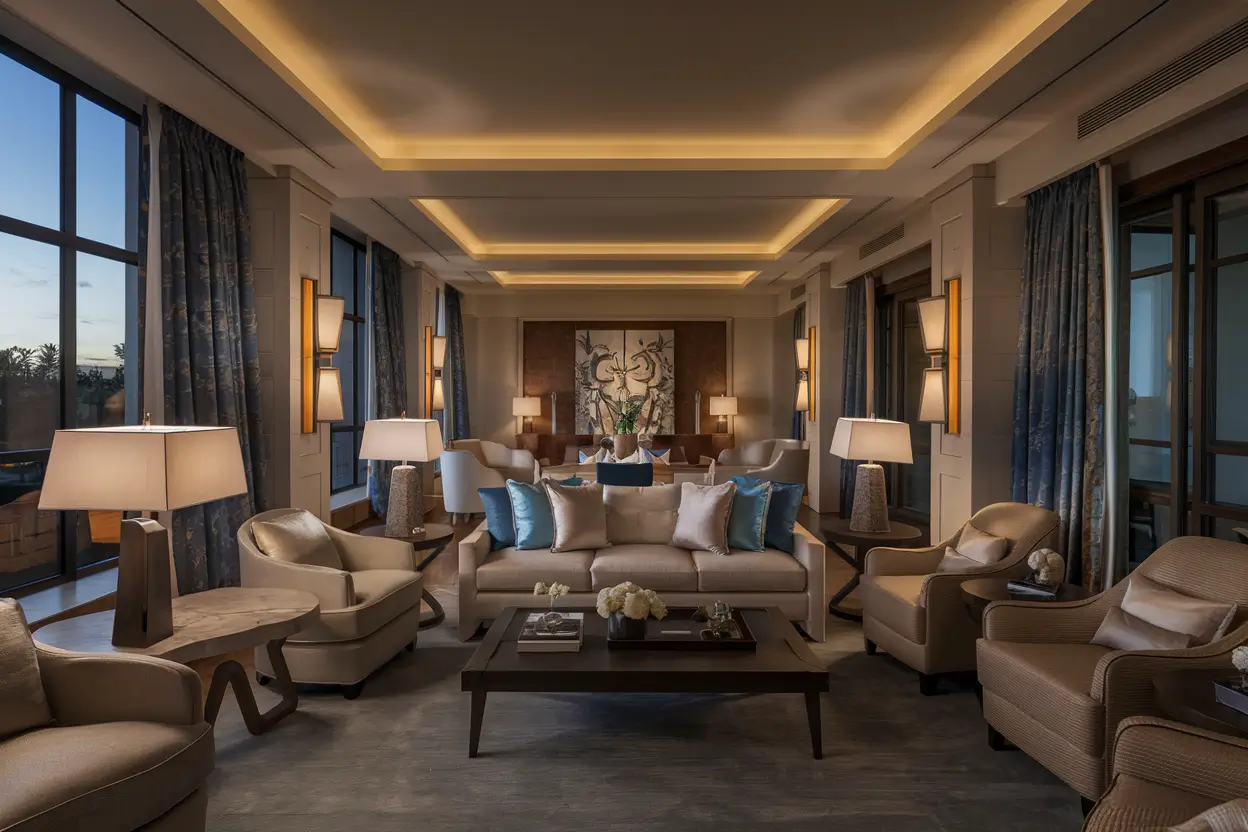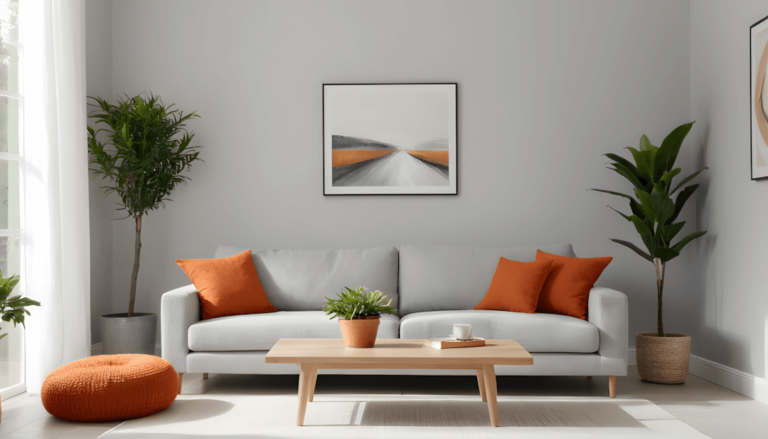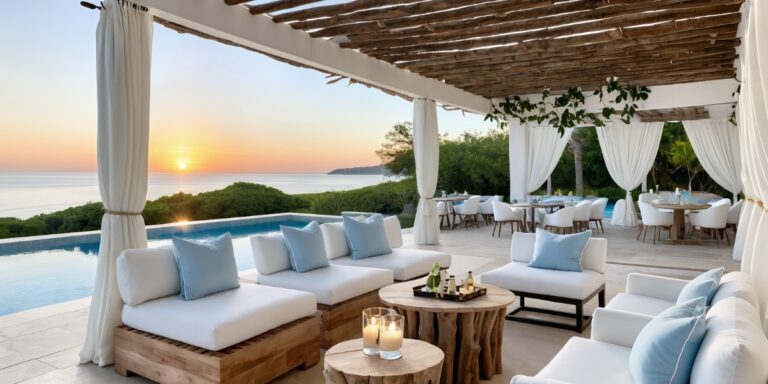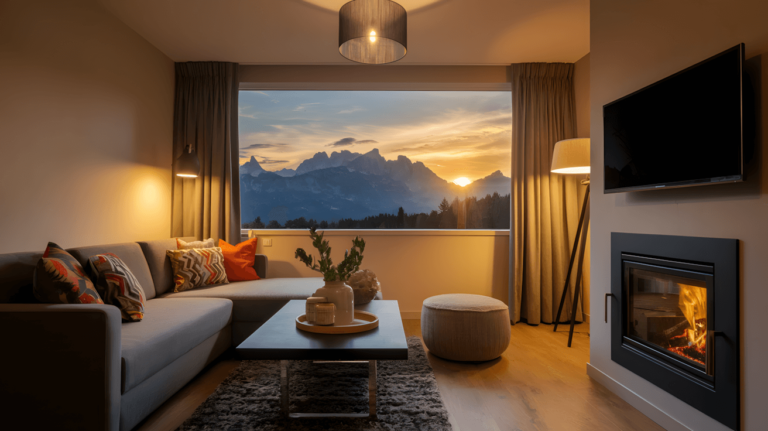You walk into the Four Seasons lobby after a long day, and you instantly feel your shoulders relax.
The lighting isn’t harsh or clinical—it’s warm, layered, and somehow makes everything look more beautiful, including you. That same transformative ambiance isn’t reserved for luxury hotels anymore.
After spending countless evenings in poorly lit living rooms that felt more like waiting areas than sanctuaries, I discovered that the secret to five-star ambiance isn’t expensive furniture or designer artwork—it’s mastering the art of mood lighting.
The right lighting doesn’t just illuminate a space; it transforms how you feel the moment you step inside.
In this comprehensive guide, you’ll discover 21 professionally tested lighting techniques that luxury hotels use to create their signature atmosphere.
Whether you’re working with a $50 budget or planning a complete lighting overhaul, these strategies will help you craft a living room that feels like your personal retreat rather than just another room in the house.
The Psychology Behind Hotel Lighting Magic
Before diving into specific techniques, it’s crucial to understand why hotel lighting feels so different from typical home lighting. Luxury hotels employ lighting designers who understand that humans respond emotionally to different light temperatures, intensities, and angles.
Hotels typically use what designers call “layered lighting”—combining ambient, task, and accent lighting at multiple heights and temperatures.
This creates depth and visual interest while ensuring no single light source dominates the space. The result? A room that feels balanced, sophisticated, and effortlessly comfortable.
Most living rooms rely too heavily on overhead lighting, creating what professionals call “flat” illumination.
This single-source approach eliminates shadows and depth, making spaces feel sterile and institutional. The transformation happens when you start thinking like a lighting designer instead of simply trying to make a room “bright enough.”
Foundational Lighting Layers: Your Canvas for Ambiance
1. Warm White LED Strip Lighting Behind Your TV
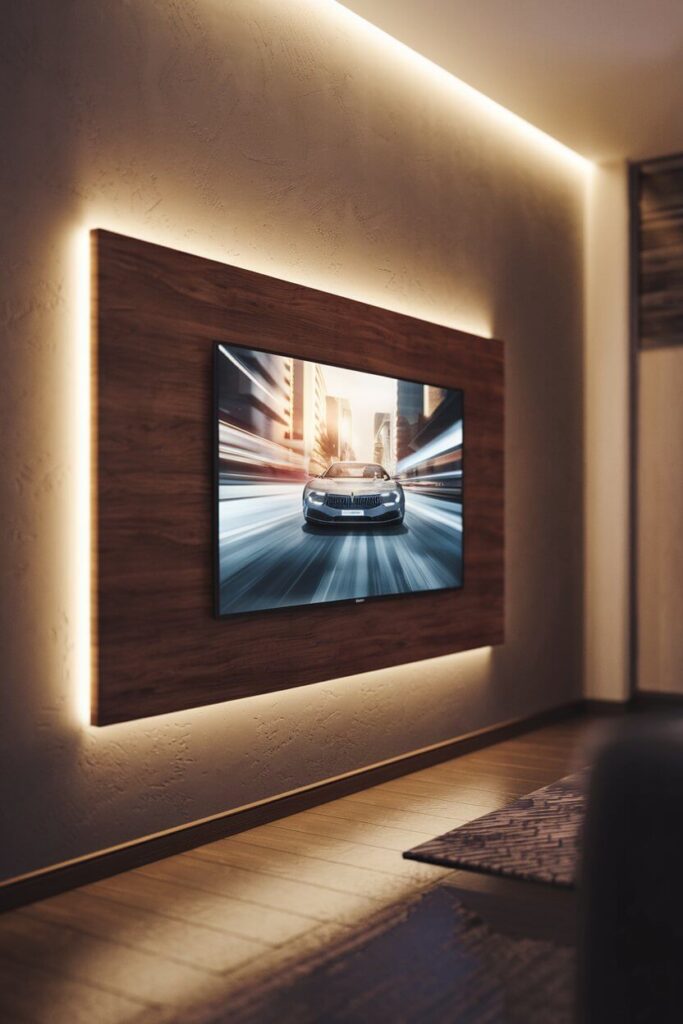
Transform your entertainment center from a black rectangle into a glowing focal point using LED strips with 2700K color temperature.
Mount the strips on the back edge of your TV or entertainment console, ensuring the light bounces off the wall rather than shining directly into the room.
Why it works: This technique, called backlighting, reduces eye strain during movie nights while adding a subtle glow that makes your TV appear to float. Hotels use this same approach with artwork and architectural features.
Pro tip: Choose strips with dimming capability and avoid RGB strips that cycle through colors—they’ll make your space feel more like a gaming setup than a luxury hotel.
2. Floor-to-Ceiling Corner Uplighting
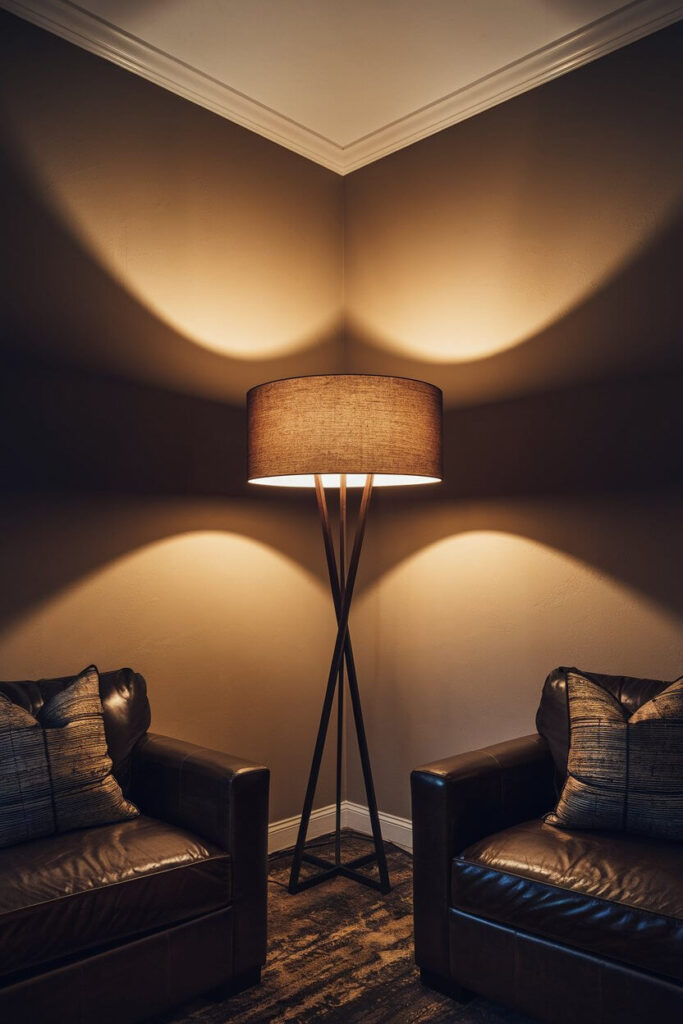
Position a sleek floor lamp in at least one corner, directing light upward toward the ceiling.
The Brightech Sky LED Torchiere or similar minimalist designs work exceptionally well for this purpose.
Best for: Rooms with standard 8-9 foot ceilings where you want to create the illusion of height and space. This technique makes ceilings appear higher by washing them with soft, even light.
Implementation secret: Place the lamp slightly away from the corner rather than directly in it. This creates a more gradual light gradient and prevents harsh shadow lines where the walls meet.
3. Strategically Placed Table Lamps at Varying Heights
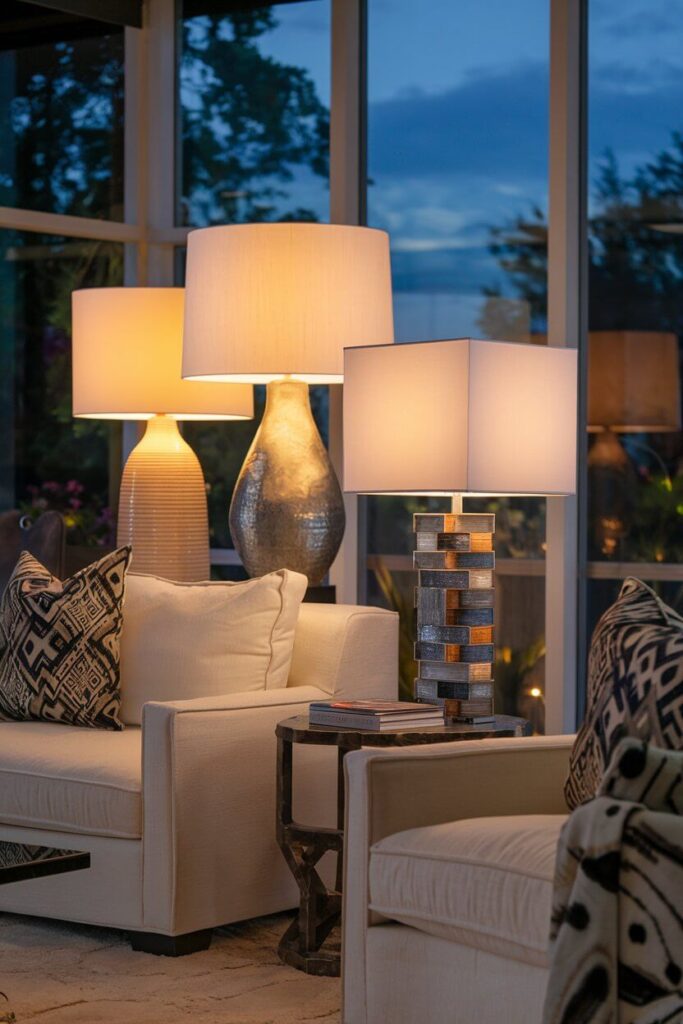
Create visual rhythm by positioning table lamps at three different heights throughout your space. Use side tables, console tables, and even floating shelves to establish this varied landscape.
The hotel approach: Luxury establishments rarely place lamps at the same height because it creates monotony. Instead, they stagger heights to guide the eye naturally around the room and create multiple zones of intimate lighting.
Common mistake: Choosing lamp bases that are all the same material or color. Mix textures—combine ceramic, metal, and natural materials for the layered look hotels master.
Accent Lighting That Creates Drama
4. Picture Lights for Wall Art Illumination
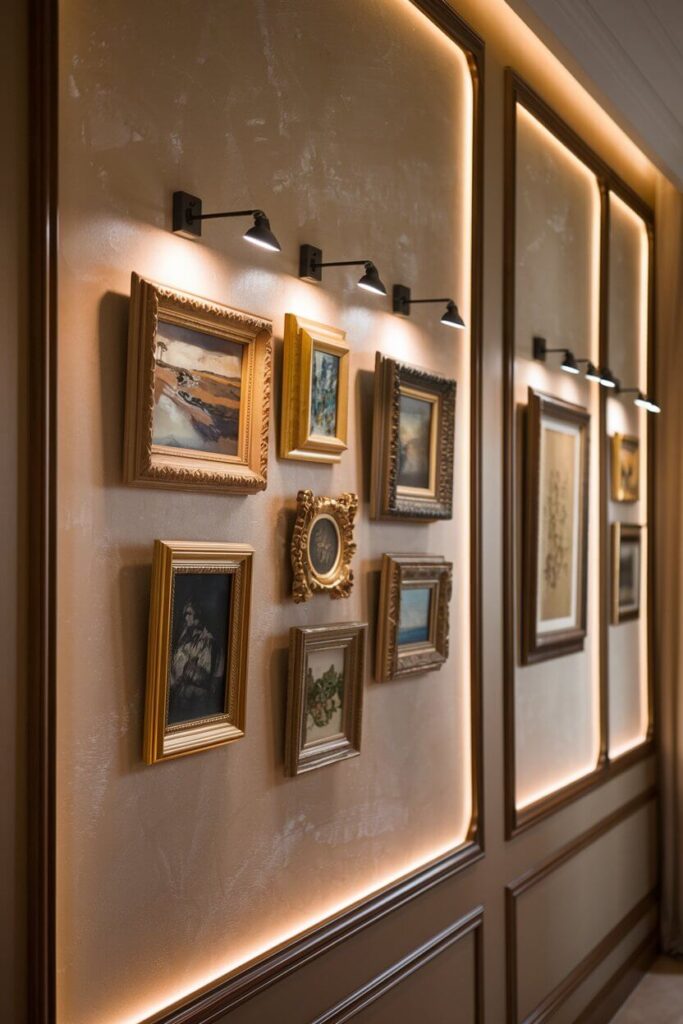
Install small LED picture lights above your artwork, photographs, or even empty frames used as decorative elements. Battery-operated options eliminate the need for electrical work while providing the same upscale effect.
Why hotels love this: Illuminated artwork adds sophistication while creating pools of light at eye level, making spaces feel more intimate and gallery-like.
Insider technique: Use picture lights with adjustable heads so you can direct light onto the artwork without creating glare. The goal is to make the art glow, not the light fixture itself.
5. Bookshelf and Built-In Lighting
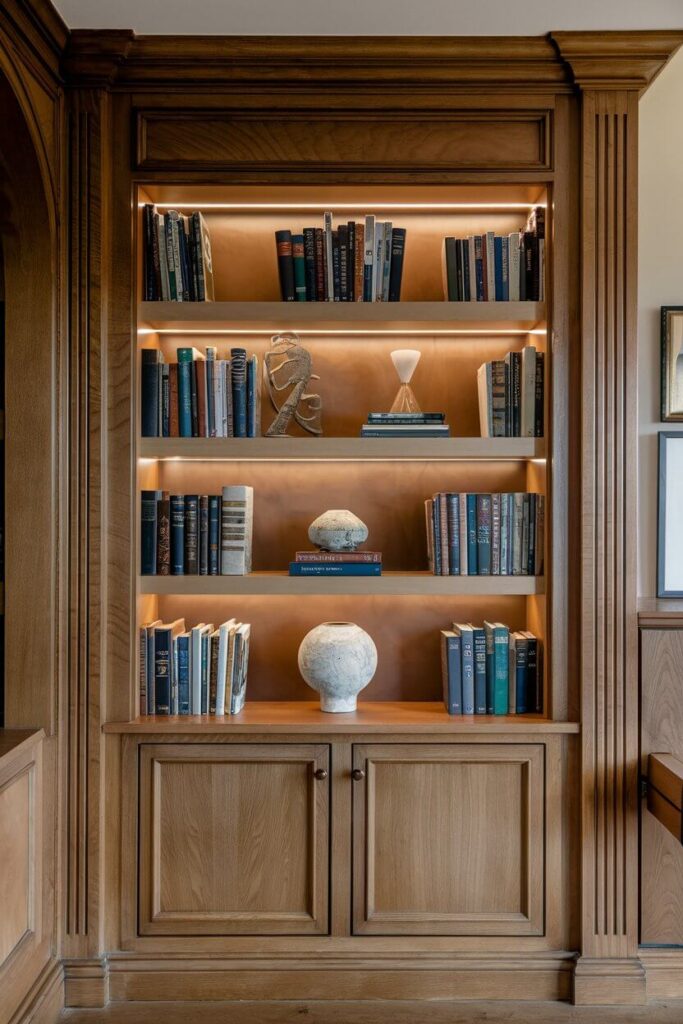
Add battery-operated LED puck lights or thin LED strips inside bookshelves, display cabinets, or built-in storage areas. This technique highlights your decorative objects while adding depth to your room’s lighting scheme.
Perfect for: Showcasing collections, architectural details, or creating the illusion that your bookcases are custom built-ins rather than standalone furniture.
Professional tip: Cool white LED (4000K) works better for highlighting objects and books, while warm white is better for ambient lighting. Don’t be afraid to mix color temperatures strategically.
6. Statement Chandelier or Pendant Light
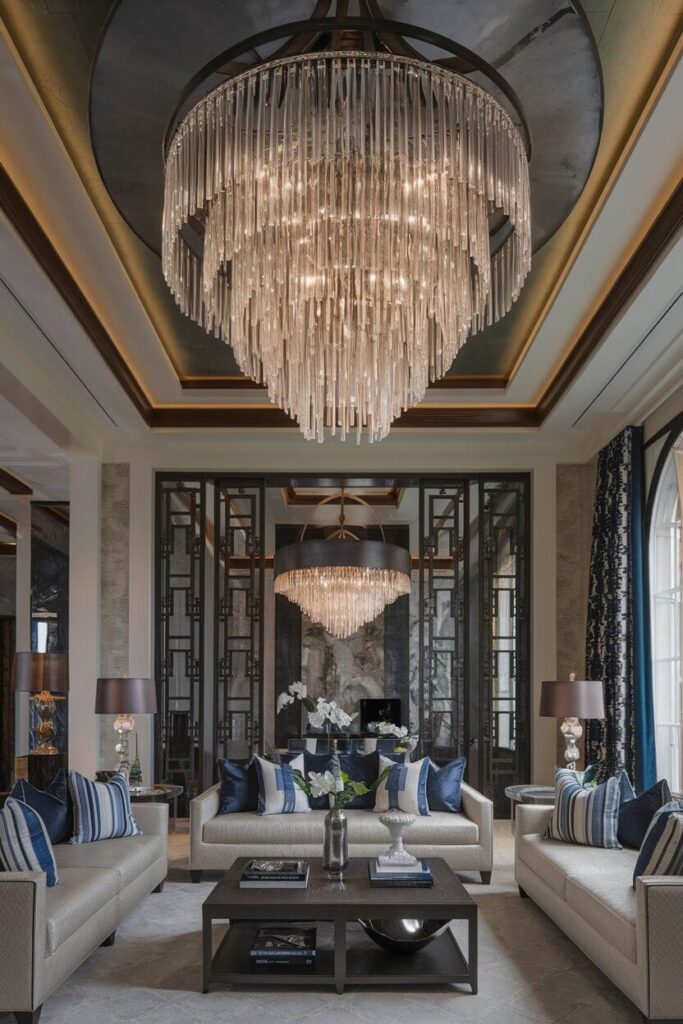
Replace or supplement your overhead fixture with a dramatic chandelier or oversized pendant light that serves as both illumination and art piece. Think of it as jewelry for your room.
Hotel strategy: Five-star properties use statement lighting as conversation pieces. The fixture should be large enough to anchor the seating area—typically one-third the width of your coffee table.
Budget consideration: Thrift stores and Facebook Marketplace often have unique vintage fixtures that just need rewiring or a fresh finish to become stunning centerpieces.
Ambient Temperature Control Through Lighting
7. Candles and Flameless Candles for Ultimate Warmth
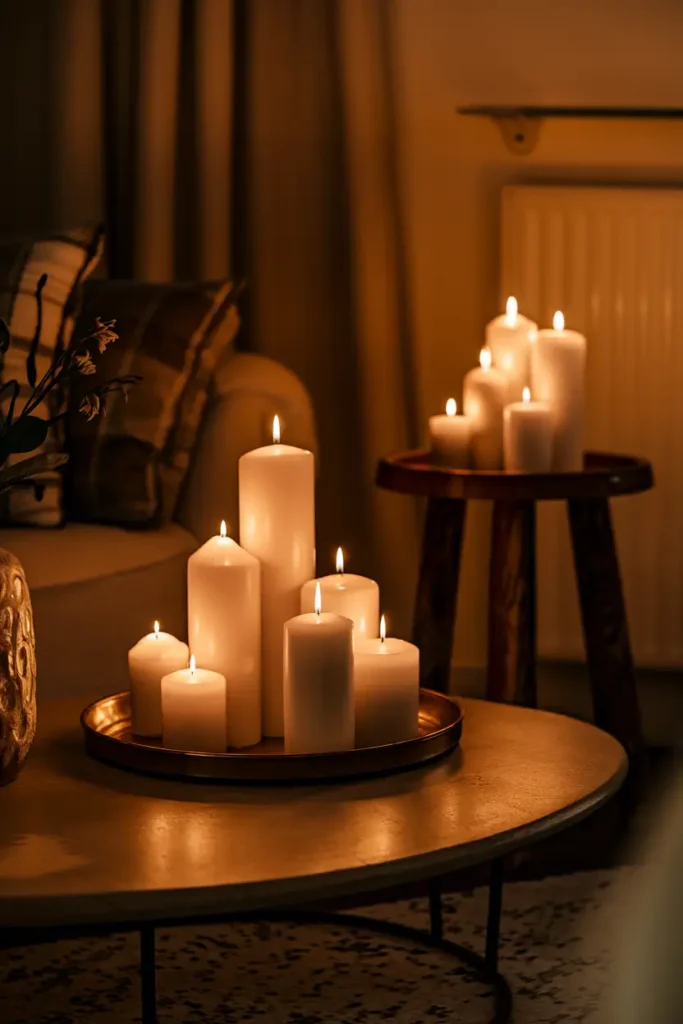
Create the most luxurious ambiance possible with real candles clustered in groups of three or five. For safety and convenience, high-quality flameless candles with timers offer the same visual warmth without fire concerns.
The psychology: Flickering light triggers relaxation responses in humans because it mimics the firelight our ancestors gathered around for centuries. Hotels understand this primal comfort.
Styling secret: Use candles of varying heights within each grouping, and place them at different depths on surfaces to avoid the “lined up soldiers” effect.
8. Himalayan Salt Lamps for Natural Glow
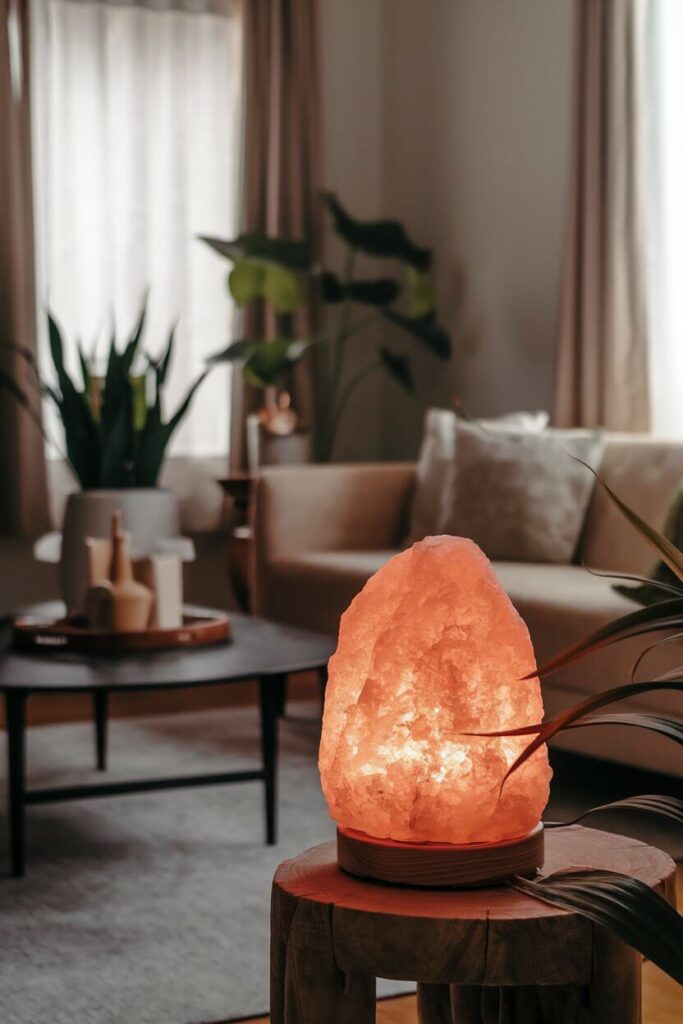
Position one or two authentic Himalayan salt lamps in quieter corners of your living room. Their warm, orange-pink glow adds an organic element that balances more technological lighting sources.
Best placement: Away from high-traffic areas where they might be bumped, and preferably where their unique texture can be appreciated. They work beautifully on end tables or console surfaces.
Quality matters: Authentic salt lamps have irregular surfaces and natural color variations. Perfectly smooth or uniformly colored versions are often fake and won’t provide the same warm light quality.
9. Fireplace Enhancement Lighting
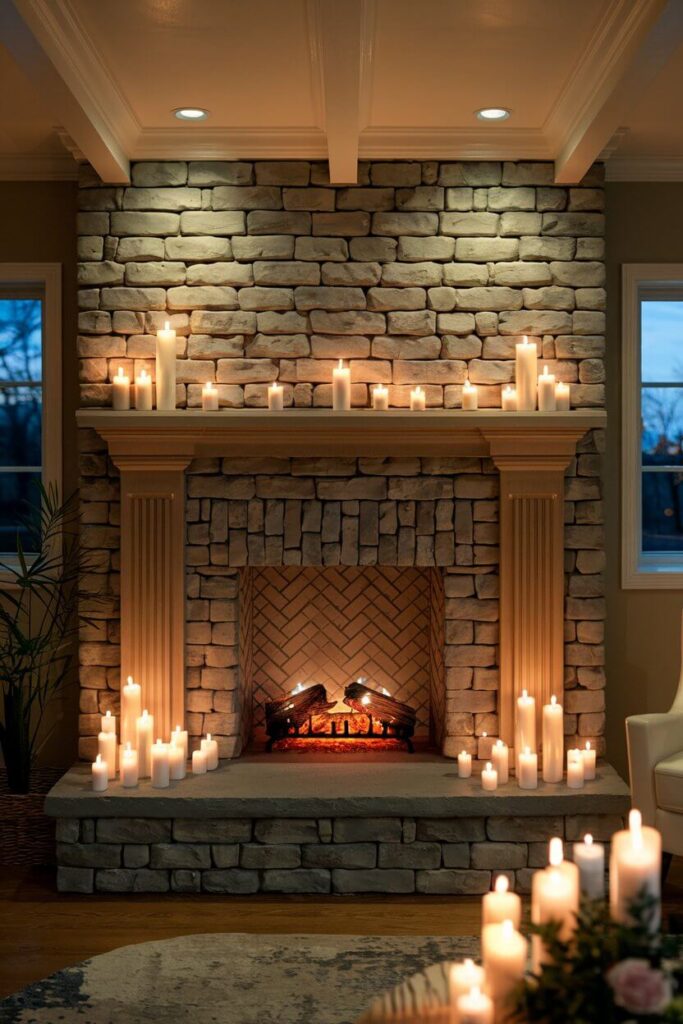
If you have a fireplace, enhance it even when not in use by adding LED strip lights along the interior back wall or placing battery-operated candles on the hearth.
For non-functional fireplaces: Fill the firebox with white pillar candles of various heights, or install a small LED strip to simulate a gentle glow.
Hotel technique: Many luxury hotels place small spotlights to highlight fireplace surrounds and mantels, making them focal points even during daytime hours.
Modern Smart Lighting Solutions
10. Smart Bulbs with Scheduling and Dimming
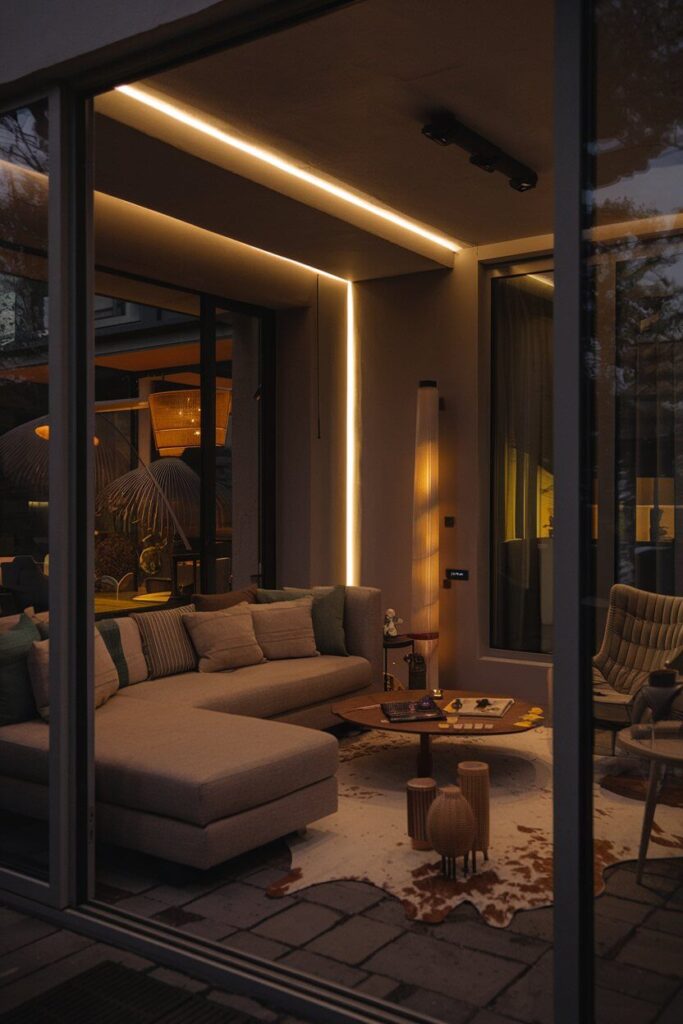
Replace your most-used light bulbs with smart bulbs that can be programmed to automatically dim throughout the evening, mimicking natural sunset patterns.
Why it transforms your space: Hotels use lighting management systems to automatically adjust light levels throughout the day. Smart bulbs bring this professional approach to your living room.
Setup strategy: Start with 2-3 key fixtures rather than trying to make every light smart at once. Focus on your main table lamps and any overhead fixtures you use regularly.
11. Motion-Activated Accent Lighting
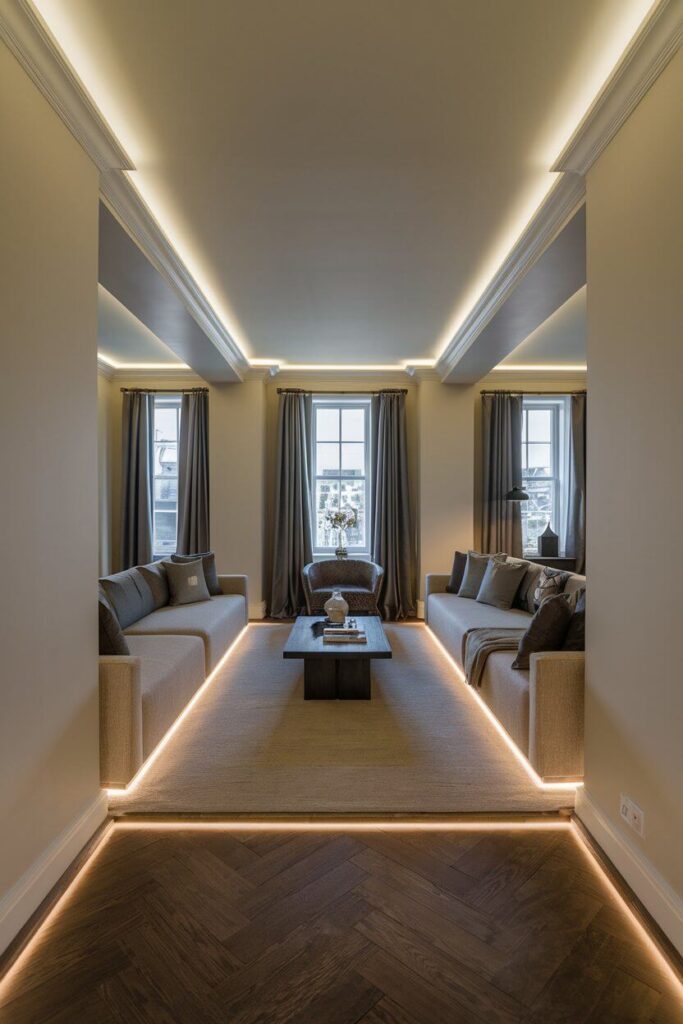
Install battery-powered LED strips with motion sensors under furniture, along baseboards, or behind large plants. This creates subtle wayfinding light that activates automatically.
Professional application: High-end hotels use similar lighting to guide guests safely through spaces without harsh overhead illumination during evening hours.
Placement tips: Focus on transition areas—between seating areas, near entryways, or along pathways through the room.
12. Color-Changing LED Strips for Seasonal Moods
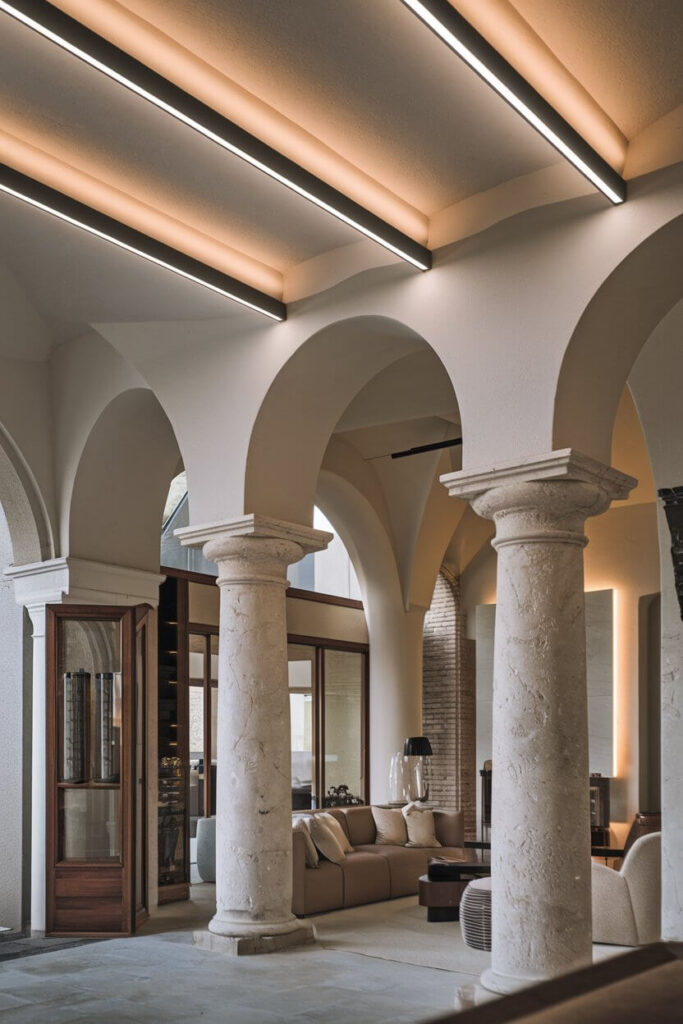
Use programmable LED strips behind furniture or architectural features that can shift from warm white for everyday use to seasonal colors for special occasions.
The luxury hotel approach: Exclusive properties change their accent lighting colors subtly throughout the year—slightly cooler in summer, warmer in winter.
Restraint is key: Use color-changing features sparingly. The goal is subtle enhancement, not nightclub effects.
Creative and Unconventional Lighting Ideas
13. Mirror Backlighting for Depth Illusion
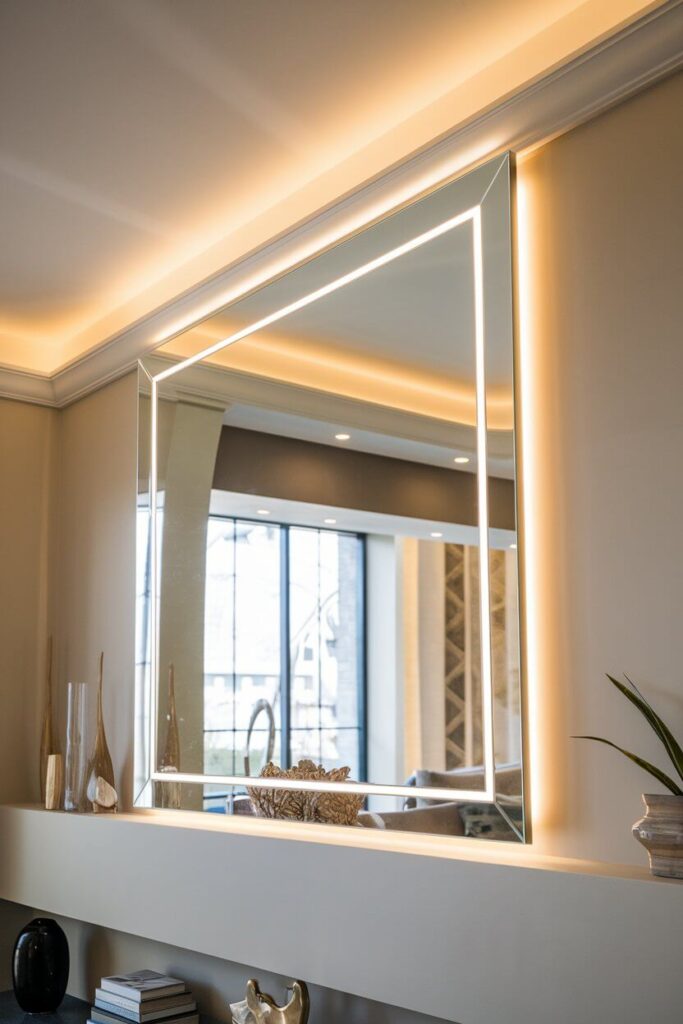
Install LED strips behind large mirrors to create a floating effect while doubling the perceived light in your space through reflection.
Space enhancement: This technique makes rooms appear larger and brighter by bouncing light around the room multiple times.
Installation secret: Mount the strips on the wall behind the mirror, ensuring no direct light is visible from normal viewing angles.
14. Lighting Inside Glass Vases and Containers
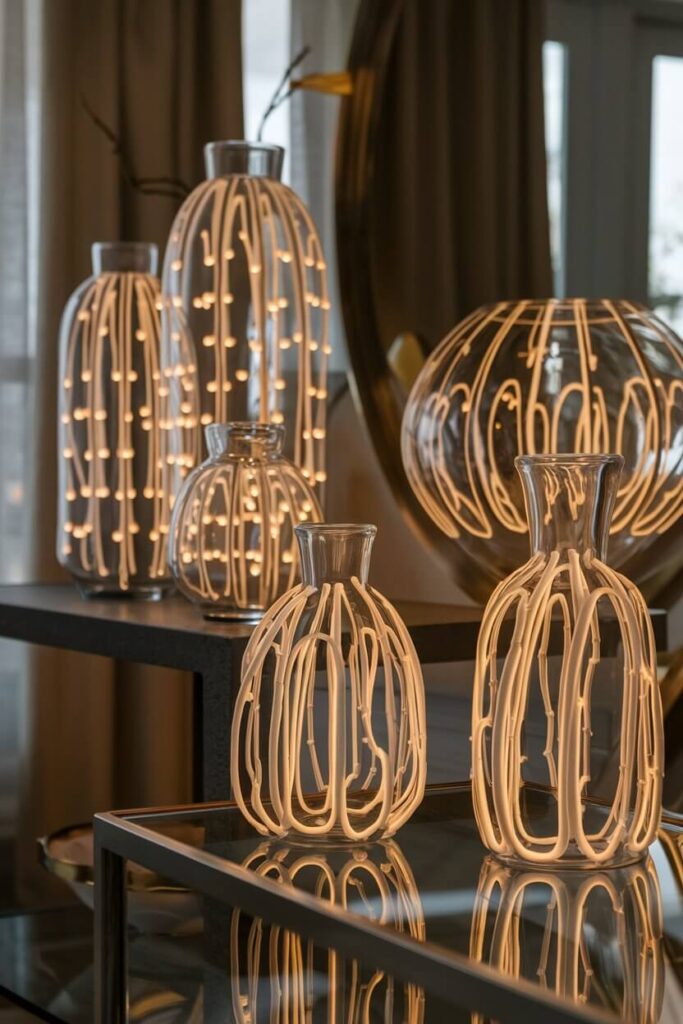
Place small LED string lights or battery-powered LED puck lights inside large glass vases, apothecary jars, or clear decorative containers.
Visual impact: Creates stunning illuminated sculptures that serve as both art and light source. Hotels often use this technique in lobby displays.
Material considerations: Use only battery-powered LED lights to avoid heat issues, and ensure the container is large enough that the light source doesn’t look cramped.
15. Plant Uplighting for Natural Drama
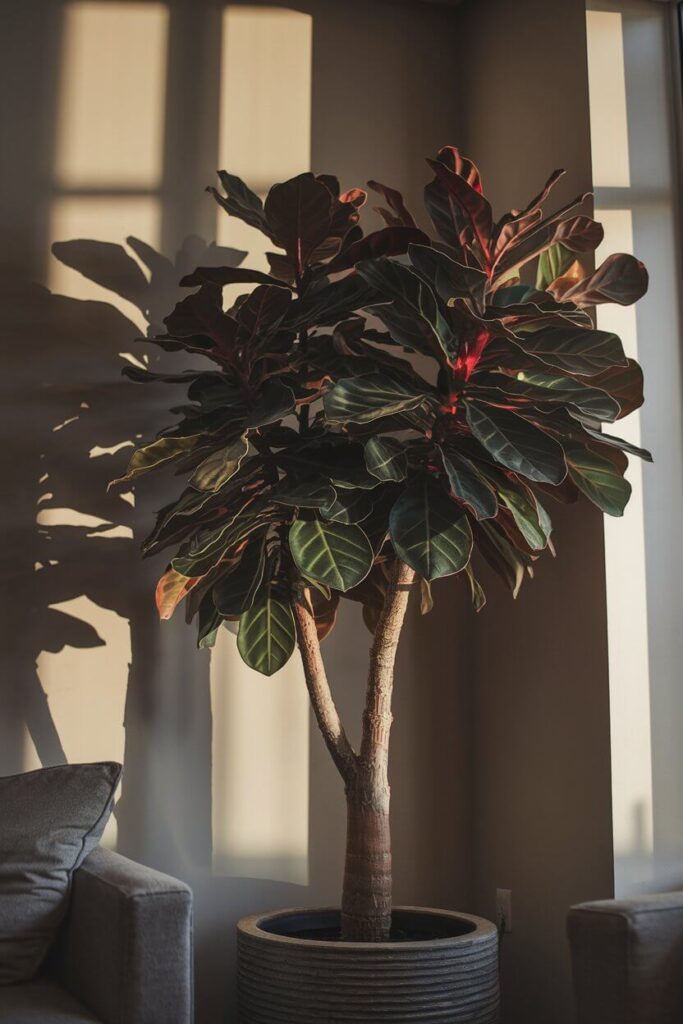
Position small spotlights or uplights at the base of large plants to cast dramatic shadows on walls and ceilings.
Hotel inspiration: Luxury properties use this technique to make their plants appear more architectural and significant within the space.
Plant selection: Works best with plants that have interesting leaf shapes—fiddle leaf figs, monstera, or large palms create the most dramatic shadow patterns.
16. Window Frame LED Enhancement
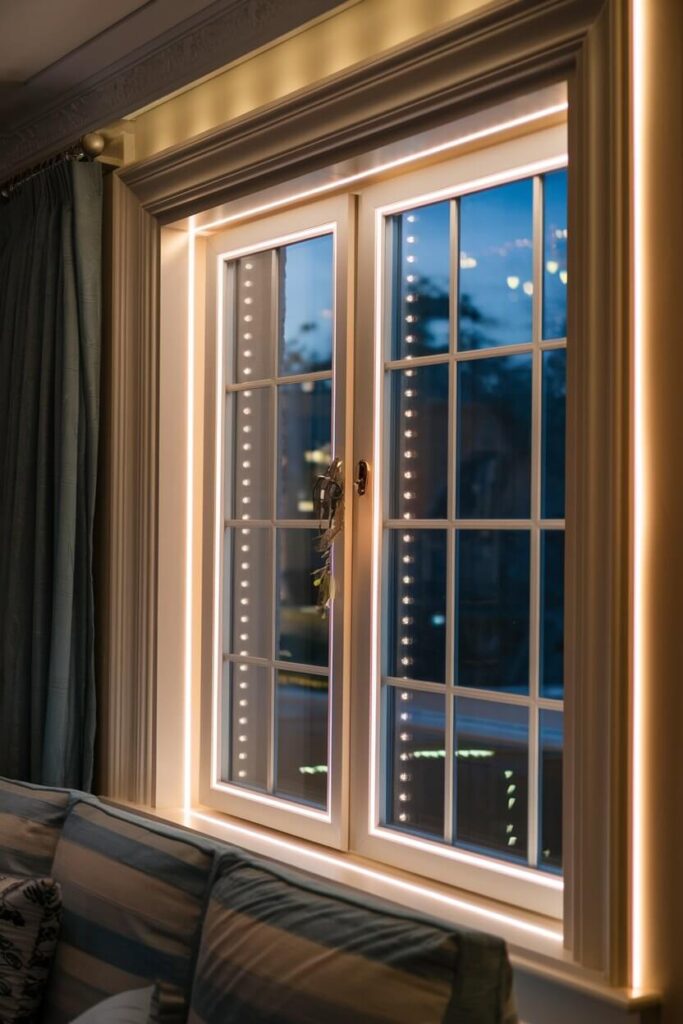
Install thin LED strips around window frames to create the illusion that natural light is streaming in, even during evening hours.
Psychological benefit: Maintains connection to outdoor light even when curtains are drawn, preventing the closed-in feeling that can occur with heavy window treatments.
Color temperature: Use daylight-balanced LEDs (5000K-6500K) for this application to maintain the natural light illusion.
Budget-Friendly Lighting Transformations
17. String Lights with Sophisticated Styling
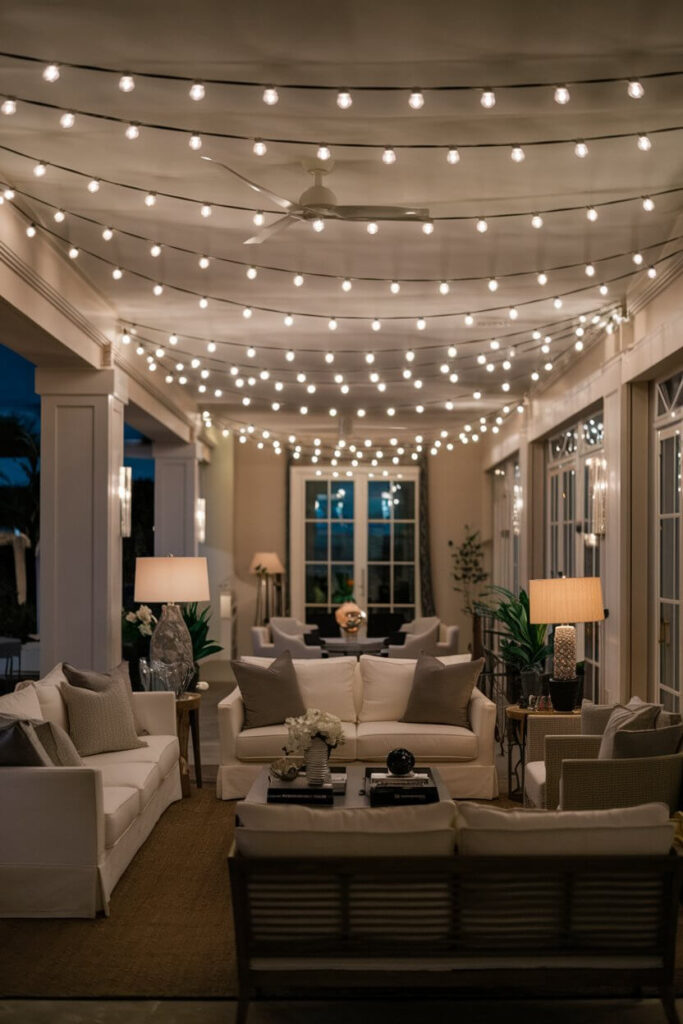
Move beyond college dorm aesthetics by using warm white string lights in unexpected ways—draped along tall furniture, woven through large plants, or arranged in geometric patterns on walls.
Elevation technique: Use string lights with larger bulbs and consistent spacing rather than tiny dense clusters. This creates a more upscale appearance.
Professional mounting: Use small clear adhesive hooks or tiny nails to create clean lines and intentional patterns rather than random draping.
18. DIY Paper Lantern Light Diffusers
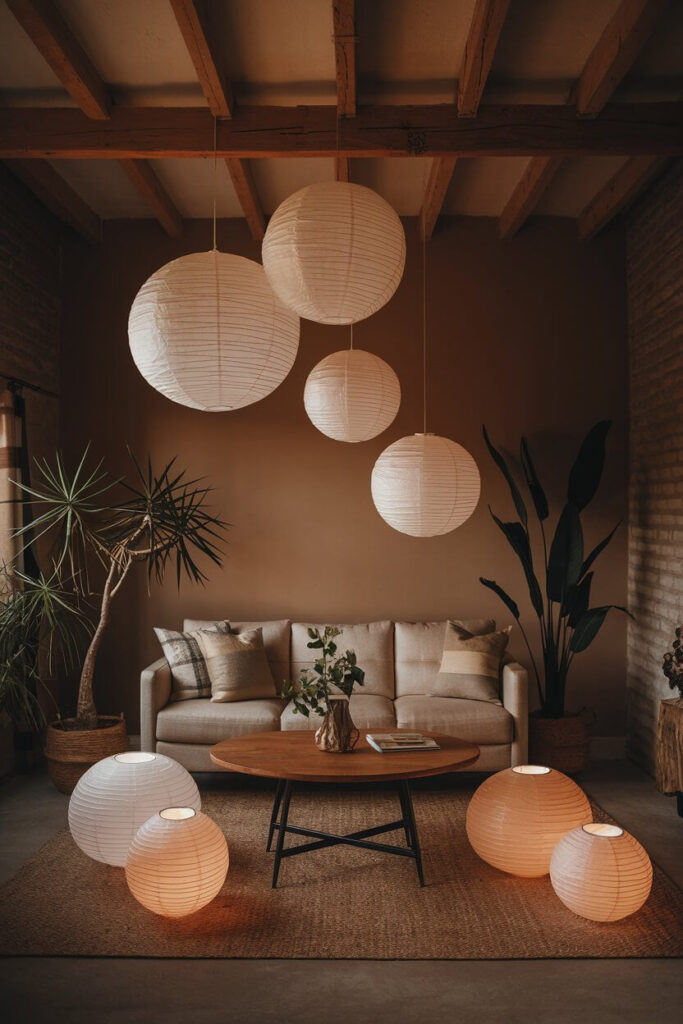
Create custom light diffusers using paper lanterns, drum lamp shades, or even large glass containers to soften harsh bulb light and add textural interest.
Customization options: Paint paper lanterns with metallic accents, wrap them in fabric, or cluster them at different heights for a high-end look.
Safety first: Always use LED bulbs in DIY fixtures to prevent heat buildup, and ensure adequate ventilation around any enclosed light source.
19. Thrift Store Lamp Makeovers
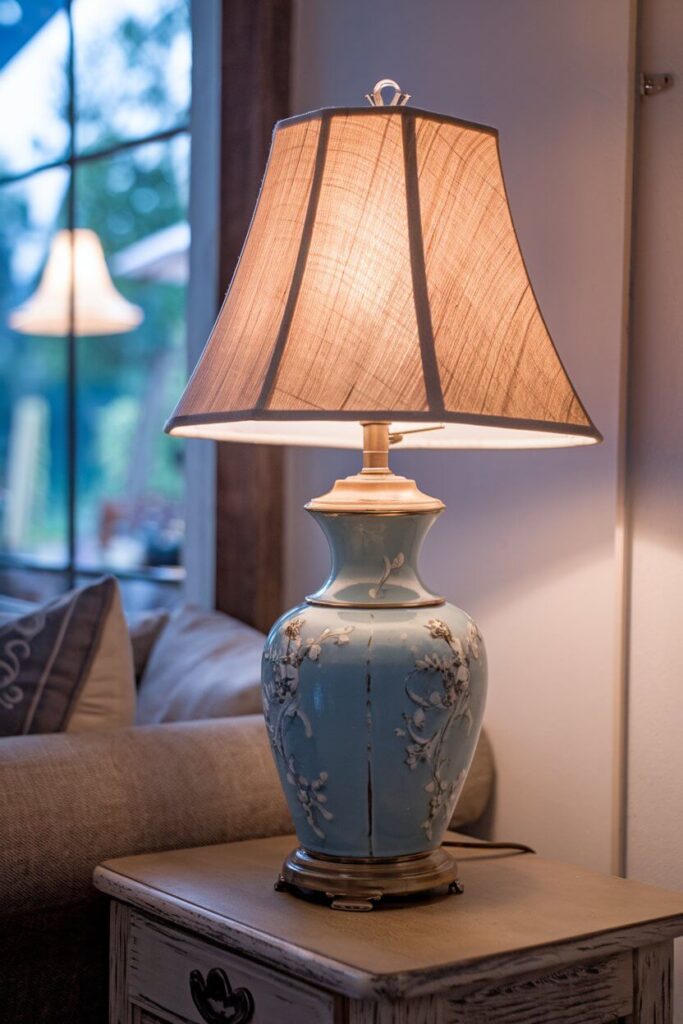
Transform outdated lamps from thrift stores by rewiring them with dimmer switches, updating the shades, or spray painting bases in contemporary finishes.
Designer secret: The proportions and bone structure of vintage lamps are often superior to modern mass-produced versions. A fresh finish can make them feel completely contemporary.
Shade selection: When in doubt, choose white or cream lamp shades. They provide the most flattering light and work with any decorative style.
Professional Installation and Advanced Techniques
20. Recessed Lighting with Dimmer Controls
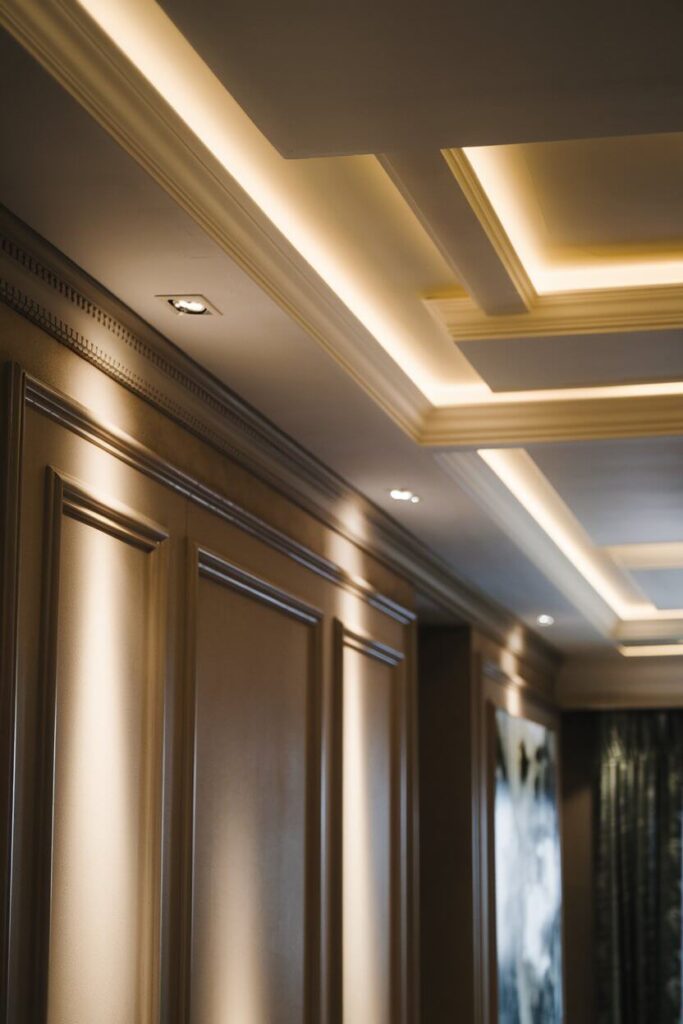
If you’re planning electrical work, strategically placed recessed lights with high-quality dimmer switches provide the ultimate in ambient lighting control.
Hotel-quality approach: Use recessed lights to wash walls with light rather than simply illuminating the floor. Angle adjustable fixtures toward walls and artwork.
Dimmer quality matters: Invest in electronic dimmers designed for LED bulbs. Cheap dimmers can cause flickering and reduce bulb lifespan.
21. Integrated Home Automation Systems
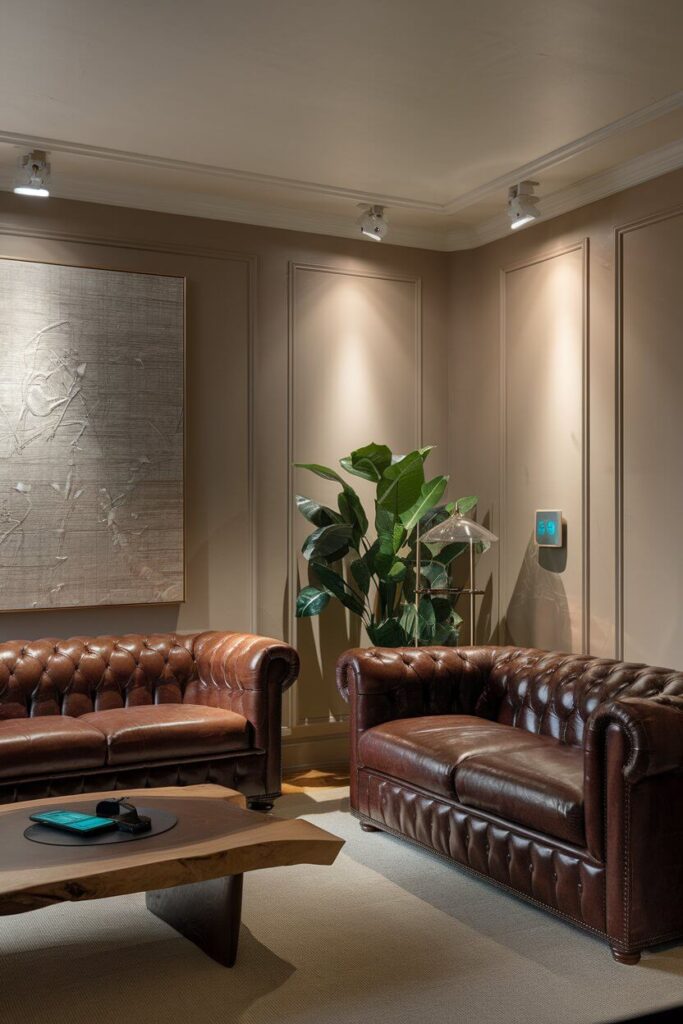
Create the ultimate luxury experience with a lighting control system that manages all your lights through a single app or voice command system.
Professional benefits: Allows you to create multiple “scenes”—bright for cleaning, medium for entertaining, dim for evening relaxation—that activate instantly.
Future-proofing: Even if you start with just a few smart switches, choose a system that can expand as your needs and budget grow.
Common Lighting Mistakes That Destroy Hotel Ambiance
Overhead-only lighting: Relying solely on ceiling fixtures creates harsh, institutional lighting that immediately destroys any luxury ambiance.
Wrong bulb color temperature: Mixing cool white (4000K+) and warm white (2700K-3000K) bulbs randomly throughout a room creates visual chaos.
Insufficient dimming options: Lights that only turn on and off can’t adapt to different moods and times of day.
Ignoring light placement: Putting lights where they’re convenient rather than where they’re most effective for ambiance.
Forgetting about shadows: Good lighting creates interesting shadows and depth rather than eliminating all shadows completely.
Creating Your Personal Hotel Lighting Plan
Start with assessment: Walk through your living room at different times of day and note where the space feels flat, harsh, or unwelcoming. These problem areas will guide your lighting priorities.
Budget allocation strategy: Invest 40% of your lighting budget in ambient lighting (the foundation), 35% in accent lighting (the drama), and 25% in task lighting (the functionality).
Timeline approach: Implement changes gradually over 2-3 months rather than all at once. This allows you to understand how each addition affects the overall ambiance before adding the next layer.
Seasonal adjustments: Plan for lighting that can adapt to seasonal changes. Warmer, dimmer lighting feels more appropriate during winter months, while slightly brighter, cooler lighting works better in summer.
Your Next Steps to Five-Star Living
The transformation from ordinary living room to luxury hotel ambiance doesn’t happen overnight, but every lighting change you make brings you closer to that goal.
Start with one technique that excites you most—perhaps warm LED strips behind your TV or a few strategically placed table lamps at different heights.
Remember that luxury hotels spend thousands of dollars on professional lighting design, but the principles they use can be adapted to any budget.
The key is understanding that lighting is about creating feeling, not just visibility.
Your living room should be your favorite room in the house—the place where you naturally want to spend time, where guests feel immediately welcomed, and where you feel most relaxed after challenging days. With these 21 lighting strategies, you have everything needed to create that five-star sanctuary.
The only question left is: which lighting transformation will you try first?

